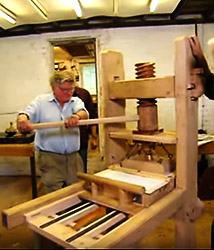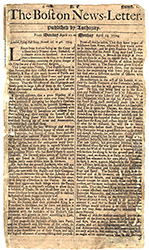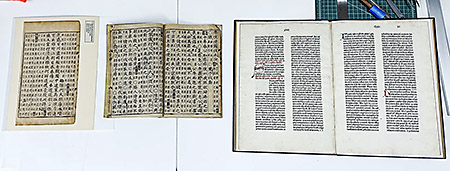Printing
This chapter covers the origins of printing text and illustrations on paper with ink.
Evolving from seals and stamps, woodblock printing was the first efficient method of printing large numbers of copies on paper. The origins of this method can be traced to China in the first few centuries of the current era. Moveable type printing also can be traced to China, a few centuries before Gutenberg, but his printing press appears to have had the greatest impact on culture, particularly in the West.
TOPICS
• Printing predecessors: Seals and stamps; stone rubbings
• Woodblock printing
• First mass printing, first block prints, European block books
• Intaglio: Engraving, etching
• First moveable type
• Early moveable type books
• Gutenberg’s press
• Type slugs: Punch and matrix, type mold, type setting
• Moveable type press: Press parts, ink, operation
• The Nuremburg Chronicle
• Typography: Terminology, categories
• Printing’s impact
• Ink stamp illustration
• Stone rubbing illustration
• Woodblock printing - 4 panels
• Intaglio printing
• Bi Sheng clay slugs illustration
• First metal slugs graphic
• Making slugs graphics - 8 panels
• Type setting graphic - 2 panels
• Type slug duplicates illustration
• Moveable type press illustration
• Moveable type press parts graphic
• Moveable type press ink illustration
• Moveable type press operation - 5 panels
• Type terminology graphic
• Type categories graphic
• Double press illustration
• Literacy rates in England 1625-1925 graphic
• Diamond Sūtra frontispiece
• European block books - 2 photos
• Dürer: Melancholia I
• Korean Jikji page
• Nuremberg Chronicle pages - 3 photos
Printing as we think of it, lines of text impressed in ink on paper, probably began in China some time in or before the 7th century CE. The oldest known printed document of this kind is from the early 8th century, a small dharani woodblock print discovered in 1966 at a temple in Korea.
Printing patterns on fabric precedes printing on paper, starting some time in the 2nd century in China. And various other methods of making copies of text and images are also older, including stone rubbings, stencils and stamps. As discussed in the chapter on writing, stamps and cylinder seals were used in the Middle East thousands of years earlier, principally to make impressions in clay, and the use of stamps and seals was common in many parts of the world.
But none of those earlier methods of reproduction were of much use in making multiple copies of written text or drawn images. Making copies from stone inscriptions or by using stencils took a long time for each copy, and stamps had size limitations.
Woodblock printing was the first technology that allowed copies to be made more efficiently, and which led to the first mass distributions of printed material.
Next came the concept of moveable type, with each character on its own block. The earliest known use of this method was in the 11th century in China, but it didn’t gain widespread use.
Gutenberg’s moveable type press was built in the mid-15th century in Germany. This was the innovation that is often cited as revolutionizing communication, as similar presses appeared across Europe and eventually the world over the next several centuries, making all manner of printed material available to broad audiences.
Earliest Printing
A Chronology of Printing. Colin Clair, Cassell 1969.
Handbook to Life in Ancient Mesopotamia 1st Edition. Stephen Bertman, Oxford University Press 2005.
The Invention of Printing in China and its Spread Westward. Thomas Francis Carter, NY Columbia U. Press 1925.
Paper and Printing in Ancient China. Berthold Laufer, Caxton Club 1931.
Media
Aramaic and Figural Stamp Impressions on Bricks of the Sixth Century B.C. from Babylon. Joachim Marzahn, Benjamin Sass, Harrassowitz 2010.
Cylinder Seals in Ancient Mesopotamia - Their History and Significance. Joshua J. Mark, World History Encyclopedia, Dec. 2, 2015.
Seals In Antiquity. John Cherry, Britannica.com, July 26, 1999.
Mesopotamian Seals. cdli.ucla.edu.
Inkston Oriental Arts and Materials. Inkston.com.
Pre-Gutenberg
The History of Pre-Gutenberg Woodblock and Movable Type Printing in Korea. Hye Ok Park, International Journal of Humanities and Social Science Vol. 4, No. 9(1), July 2014.
The Shorter Science and Civilisation in China, Volume 4, p. 14. Needham, Joseph, Cambridge University Press 1994.
The Earliest Surviving Book Printed from Movable Metal Type. Jeremy Norman, historyofinformation.com 2021.
Introduction to Jikji. prkorea.com.
Movable Type—the very first printer and a brief look at its history. Ross Albert Tejada, medium.com, Dec. 2, 2017.
Pre-Gutenberg Printing. The Shoyen Collection.
Woodblock
Japanese Print-Making: A Handbook of Traditional & Modern Techniques. Toshi Yoshida and Rei Yuki, Charles E. Tuttle 1966.
Japanese Woodblock Printing. Rebecca Salter, University of Hawaii Press 2002.
Chinese Woodblock Printmaking. Eva Pietzcker, druckstelle.info, 2021.
The Invention of Woodblock Printing in the Tang (618–906) and Song (960–1279) Dynasties. Asian Art Museum, San Francisco, CA.
Yangliuqing woodblock printing thrives for nearly 400 years. en.people.cn, Jan. 16, 2019.
Woodblock Printing. John Steins, johnsteins.com, Jan. 19, 2010.
A History of Writings in Japanese and Current Studies in the Field of Rare Books in Japan. Zentaro Yoshimura, IFLA, Aug. 25, 1996.
China
Chinese History: A New Manual. Wilkinson, Endymion. Harvard University Asia Center for the Harvard-Yenching Institute 2012.
The Great Wall: China Against the World, 1000 BC - AD 2000. Julia Lovell, Grove Press 2007.
The Woman Who Discovered Printing. Timothy Hugh-Barrett, Yale University Press 2008.
Stone rubbing
Rubbing. britannica.com.
What is a rubbing? East Asian Library, University of California, Berkeley.
Chinese Rubbings Collection. Harvard Library.
Woodworking tools
A Carpenter’s Chest: Tools of the 15th Century. Lord Findlaech mac Alasdair, The Oak, The Arts and Sciences Newsletter for the Kingdom of Atlantia, issue #12.
Carpenter, 15th-16th Century. paleotool.com, Aug. 8, 2014.
Writing tools
History of Drawing. Thomas Buser PhD, historyofdrawing.com, University of Louisville.
The History of the Pencil. Pencils.com 2021.
Intaglio
The Intaglio Studio and Press. 21stcenturyrenaissanceprintmaker.wordpress.com, April 10, 2014.
Gutenberg press
The Machine That Made Us. Patrick McGrady director, Wavelength Films, BBC 2008.
Printing Presses: History and Development from the 15th Century to Modern Times. James Moran, University of California Press 1973.
Great Inventions and Discoveries, pp. 27-28. Willis Duff Piercy, Charles E. Merrill Co. 1911.
How the Printing Press Changed History. Nel Yomtov, Abdo Publishing, 2015.
The Invention of Printing. Theodore Low De Vinne, Francis Hart ’ Co. 1876.
Leaders of the Information Age. Edited by Clifford Thompson, The H.W. Wilson Company 2004.
Printing Press. Gordon Alley-Young, Salem Press Encyclopedia 2015.
Printing manuscripts. Aaron T. Pratt, Ransom Center Magazine, University of Texas Austin, Oct. 4, 2018.
Gutenberg’s Apprentice: Early printing – gallery of images. Alix Christie, gutenbergsapprentice.com.
The International Printing Museum. Carson, CA.
Crandall Historical Printing Museum. Alpine, UT.
Type slugs
The Typefounder’s Hand Mold. circuitousroot.com.
Setting Type by Hand. letterpresscommons.com.
The Letterpress Typesetting ’ Printing Process. Rachel Toy, spiritcreative.wordpress.com.
Bookmaking
The book: the life story of a technology pp 140–148. Nicole Howard, Greenwood Publishing Group 2005.
See the Most Luxurious Medieval Manuscripts in Existence. Anika Burgess, atlasobscura.com, Oct. 12, 2017.
Typography
A History of Graphic Design. Philip B. Meggs, John Wiley & Sons 1998.
Exploring Typography. Tova Rabinowitz, Cengage Learning 2015.
Points, picas, and other typographical terms. Merrill Perlman, Columbia Journalism Review, Aug. 19, 2019.
Sans Serif. designhistory.org 2011.
The Rise of the Sans Serif. Laura Keung, design.tutsplus.com, Dec. 2, 2020.
The History of Helvetica. imagine-express.com.
A Brief History of Sans Serif typefaces. Peter Biľak, typotheque.com, March 11, 2019.
Martin Luther
Brand Luther: How an Unheralded Monk Turned His Small Town into a Center of Publishing, Made Himself the Most Famous Man in Europe—and Started the Protestant Reformation. Andrew Pettegree, Penguin Press 2016.
The power of Luther’s printing press. Colin Woodard, The Washington Post, Dec. 18, 2015.
Social impact
A Farewell to Alms: A Brief Economic History of the World. Gregory Clark, Princeton University Press 2009.
The Better Angels of Our Nature: Why Violence Has Declined. Steven Pinker, Penguin Books 2012.
The Distribution of Wealth: A Theory of Wages, Interest and Profits. John Bates Clark, The Macmillan Company 1908.
Empathy and the Novel. Suzanne Keen, Oxford University Press; 1st edition 2010.
Great Inventions and Discoveries pp. 30-31. Willis Duff Piercy, Charles E. Merrill Co. 1911.
Leonardo’s Library: How a Renaissance Artist Discovered the Meaning of Books. Dr. Paula Findlen, Stanford U.
The Printing Press as an Agent of Change. Elizabeth L. Eisenstein, Cambridge University Press 1980.
NOTE: Weblinks were current and active at the time of the last update to the site, but may have since become unavailable or outdated. If you encounter a dead link, please notify me at phil.loubere@mtsu.edu. Thanks.
Last update: April 2021
Content related to this chapter’s topics will be periodically posted here.
Paper making, type slug casting, and Gutenberg’s press

The Machine That Made Us. Directed by Patrick McGrady, Wavelength Films, BBC 2008.
This BBC documentary provides a comprehensive account of papermaking and how Gutenberg may have cast his moveable type slugs, and what his press might have looked like and how it was operated. The book illustrations are based on the press that the BBC commissioned Professor Alan May at the University of Reading, England, to make.
First continuously published newspaper in the colony of Massachusetts

The Boston News-Letter, first published on April 24, 1704, is regarded as the first continuously published newspaper in the colony of Massachusetts.
Did Gutenberg learn moveable type printing from Korea?

Wired, Gregory Barber Aug. 29, 2022
Advanced scanning technology has shown similarities between a Gutenberg bible and Korean documents printed a century earlier using metal moveable type.
Last update: September 2022


